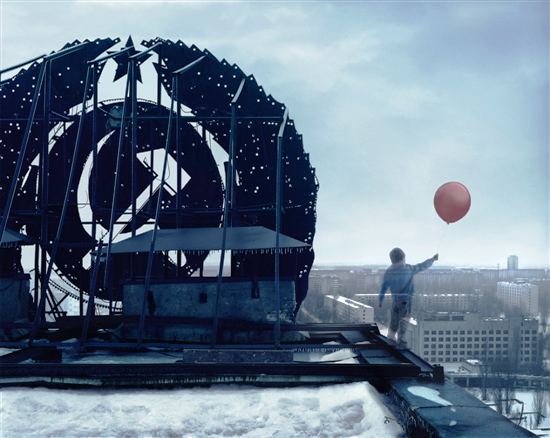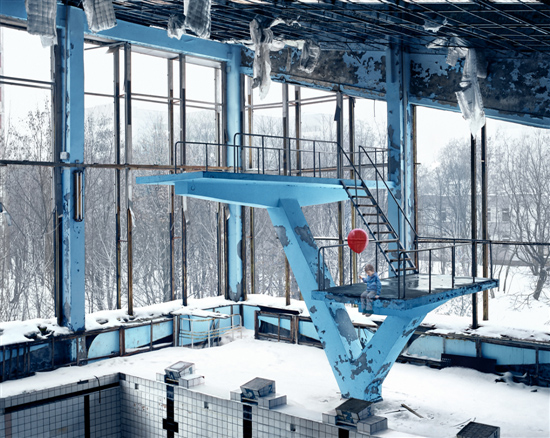Hana Vojackova, Chernobyl: Red Balloon 86, 11 Mansfield St | reviews, news & interviews
Hana Vojackova, Chernobyl: Red Balloon 86, 11 Mansfield St
Hana Vojackova, Chernobyl: Red Balloon 86, 11 Mansfield St
Walk through Chernobyl: a visual reinterpretation of an idealised Soviet documentary from 1986.
The photographer entered Chernobyl and Pripyat illegally, choosing not to travel with the bizarre tourist agency but instead, hiring a fixer who allowed her freedom to move as she wanted. He carried a gun at all times to protect her from the wolves now inhabiting the city - but not a Geiger counter to protect her from the pockets of high radiation. She snatched the images during two four-hour visits, the maximum safe time for staying inside the Zone.
But safety doesn’t seem to have concerned Vojackova. In a classroom littered with broken furniture and books lying on dust-covered desks, the boy is standing reading near to a partially smashed globe which seems like a warning that the same tragedy could happen to the rest of the world. The intruders’ presence stirred the dust which fell into Vojackova’s voluminous tangle of curls as she worked. “The radiation is mostly in the dust,” she said matter-of-factly, standing against the photographed scene in the gallery. In an abandoned child’s bedroom – the most harrowing but surprisingly peaceful scene of all, the boy is sleeping on a tatty mattress, his balloon floating in the toxic air. On the floor beside him, a gas mask and teddy bear lie on the floor.

Out in the city, Vojackova climbed up to the roof of the highest building in Chernobyl to photograph the empty city’s silent whiteness. Dominating the frame of this photograph (see right) is the dark silhouette of the cut-out metal hammer and sickle projecting above the roof, once a landmark for people below. The boy then appears in the park where a ferris wheel stands, rusting. It was due to open two weeks after the explosion but now serves as an iconic symbol of remembrance,and is also a presence in the award-winning Irish film, The Door, released last November, and set in many of the same locations. Vojackova was then embarking on her own, very different trip. A short fictional film, it poetically represents the shared experience of the population of Chernobyl through the single tragic story of a family who lost their young daughter to radiation.
In contrast, Vojackova’s installation has personal resonances tied to her memory of the event as a five-year-old living in the Soviet Czechoslovakia. Five small screens mounted on short white wooden columns present the digitally animated version of her journey through Chernobyl, with the boy now drifting like a ghost from screen to screen through each location. Vojackova had built a stage set to match the scale of each scene, and filmed him making the precise movements to match. Colour tones are manipulated to varying degrees of blueness which permeate the collection, from the ethereal paleness of polar snow to duck-egg coloured walls and swimming pool. The boy’s coloration is drained but his red balloon never fades. It is Vojackova’s acknowledgment of the influence on her of Albert Lamorisse’s award-winning 1956 film, The Red Balloon, which, in an incongruous loop, was also the model for the 1980s ad campaign for the new city of Milton Keynes.
The results of this heroic visit is almost shamefully beautiful. but the photographer admits that the sites she photographed are beautiful, "Even though we know the truth."

Photo by Hana Vojackova of one of three swimming pools in Chernobyl
- Visit The Red Balloon exhibition at 11 Mansfield Street, London W1, until 27 March.
- View clip from The Door, Oscar-nominated short film set in Chernobyl.
- View the classic 1956 French film The Red Balloon which inspired this exhibition
more Visual arts
 Fantastic Machine review - photography's story from one camera to 45 billion
Love it or hate it, the photographic image has ensnared us all
Fantastic Machine review - photography's story from one camera to 45 billion
Love it or hate it, the photographic image has ensnared us all
 Yinka Shonibare: Suspended States, Serpentine Gallery review - pure delight
Weighty subject matter treated with the lightest of touch
Yinka Shonibare: Suspended States, Serpentine Gallery review - pure delight
Weighty subject matter treated with the lightest of touch
 Jane Harris: Ellipse, Frac Nouvelle-Aquitaine MÉCA, Bordeaux review - ovals to the fore
Persistence and conviction in the works of the late English painter
Jane Harris: Ellipse, Frac Nouvelle-Aquitaine MÉCA, Bordeaux review - ovals to the fore
Persistence and conviction in the works of the late English painter
 Sargent and Fashion, Tate Britain review - portraiture as a performance
London’s elite posing dressed up to the nines
Sargent and Fashion, Tate Britain review - portraiture as a performance
London’s elite posing dressed up to the nines
 Zineb Sedira: Dreams Have No Titles, Whitechapel Gallery review - a disorientating mix of fact and fiction
An exhibition that begs the question 'What and where is home?'
Zineb Sedira: Dreams Have No Titles, Whitechapel Gallery review - a disorientating mix of fact and fiction
An exhibition that begs the question 'What and where is home?'
 Yoko Ono: Music of the Mind, Tate Modern review - a fitting celebration of the early years
Acknowledgement as a major avant garde artist comes at 90
Yoko Ono: Music of the Mind, Tate Modern review - a fitting celebration of the early years
Acknowledgement as a major avant garde artist comes at 90
 Unravel: The Power and Politics of Textiles in Art, Barbican review - the fabric of dissent
An ambitious exploration of a neglected medium
Unravel: The Power and Politics of Textiles in Art, Barbican review - the fabric of dissent
An ambitious exploration of a neglected medium
 When Forms Come Alive, Hayward Gallery review - how to reduce good art to family fun
Seriously good sculptures presented as little more than playthings or jokes
When Forms Come Alive, Hayward Gallery review - how to reduce good art to family fun
Seriously good sculptures presented as little more than playthings or jokes
 Entangled Pasts 1768-now, Royal Academy review - an institution exploring its racist past
After a long, slow journey from invisibility to agency, black people finally get a look in
Entangled Pasts 1768-now, Royal Academy review - an institution exploring its racist past
After a long, slow journey from invisibility to agency, black people finally get a look in
 Barbara Kruger, Serpentine Gallery review - clever, funny and chilling installations
Exploring the lies, deceptions and hyperbole used to cajole, bully and manipulate us
Barbara Kruger, Serpentine Gallery review - clever, funny and chilling installations
Exploring the lies, deceptions and hyperbole used to cajole, bully and manipulate us
 Richard Dorment: Warhol After Warhol review - beyond criticism
A venerable art critic reflects on the darkest hearts of our aesthetic market
Richard Dorment: Warhol After Warhol review - beyond criticism
A venerable art critic reflects on the darkest hearts of our aesthetic market
 Dineo Seshee Raisibe Bopape: (ka) pheko ye / the dream to come, Kiasma, Helsinki review - psychic archaeology
The South African artist evokes the Finnish landscape in a multisensory installation
Dineo Seshee Raisibe Bopape: (ka) pheko ye / the dream to come, Kiasma, Helsinki review - psychic archaeology
The South African artist evokes the Finnish landscape in a multisensory installation

Add comment